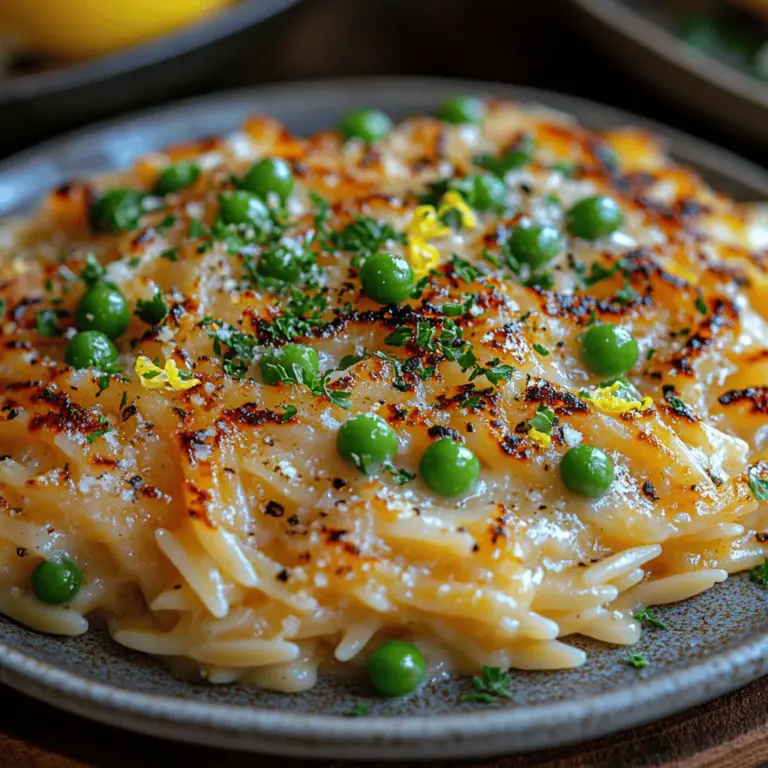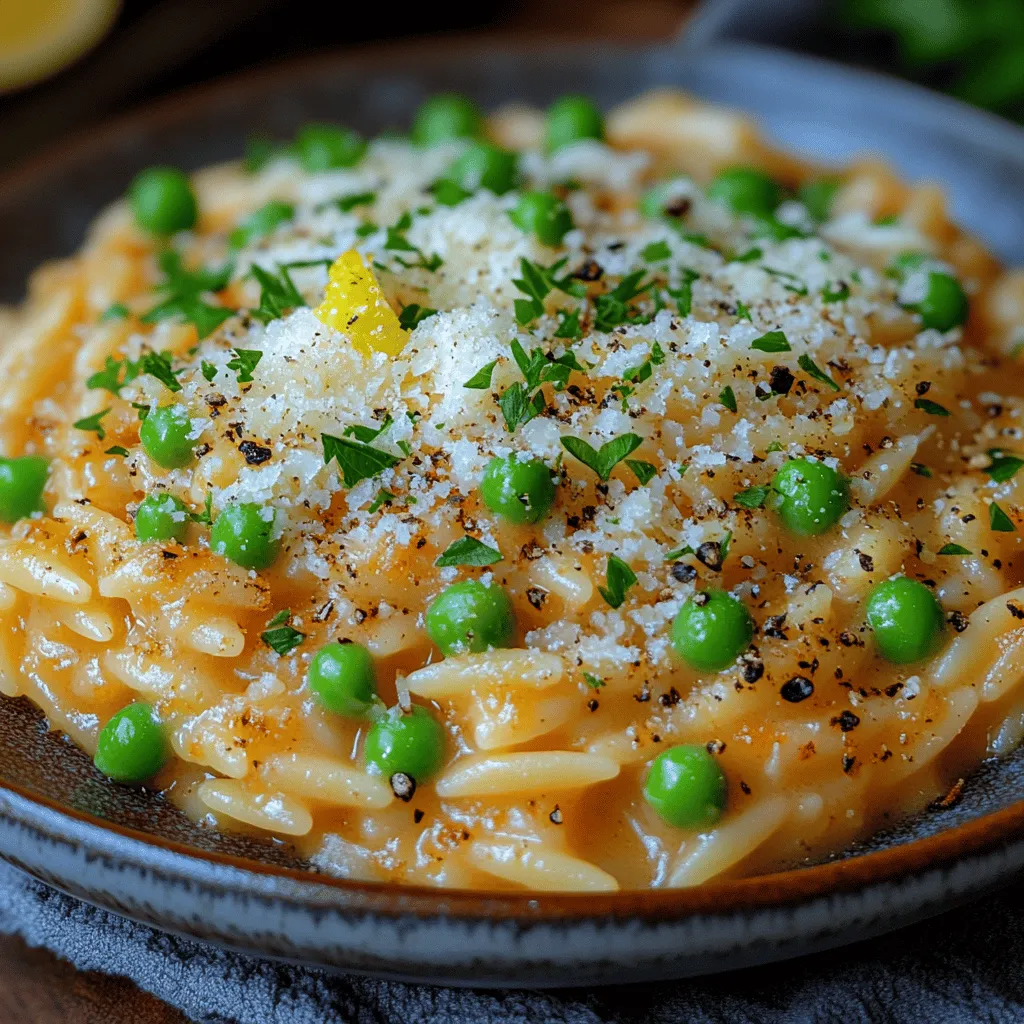Creamy Parmesan Orzo with Peas: A Comforting Culinary Delight
Creamy Parmesan Orzo with Peas is a delightful dish that masterfully combines the richness of cream and cheese with the subtle sweetness of peas, creating a pasta experience that is both comforting and satisfying. This recipe stands out due to its creamy texture and the harmonious flavor combinations that make each bite a pleasure. Whether you’re seeking a simple weeknight dinner or a sophisticated side dish for a gathering, this orzo recipe is incredibly versatile and easy to prepare.
The Allure of Creamy Parmesan Orzo
Orzo, a rice-shaped pasta, has gained popularity across various culinary traditions for its unique texture and adaptability. Originating from Italy, orzo is often used in soups, salads, and main dishes, making it a staple in many kitchens. Its small size allows it to absorb flavors beautifully, making it an excellent canvas for creamy sauces like the one in this recipe.
Creamy Parmesan Orzo with Peas can effortlessly transition from a side dish to the star of the meal, showcasing its versatility. Served alongside grilled chicken or fish, it complements proteins without overshadowing their flavors. Alternatively, it can stand alone as a hearty vegetarian dish, offering a satisfying meal that appeals to both adults and children alike. Its comfort food aspect ensures that it will quickly become a family favorite, perfect for cozy dinners or special occasions.
Essential Ingredients for Creamy Parmesan Orzo
To create this delectable dish, you’ll need a handful of essential ingredients, each contributing to the overall flavor and texture. Here’s a closer look at what you’ll require:
– Orzo Pasta: This tiny pasta shape is the heart of the dish. Orzo is available in various types, including whole wheat and gluten-free options, catering to different dietary needs. Nutritionally, orzo is a good source of carbohydrates and can provide energy for your day. Cooking time is typically around 8-10 minutes, making it a quick option for busy evenings.
– Low-Sodium Vegetable Broth: The broth plays a crucial role in enhancing the flavor of the orzo. Opting for low-sodium broth allows you to control the salt content, making it a healthier choice without sacrificing taste. The broth adds depth and ensures that every bite is infused with delicious savoriness.
– Olive Oil: This healthy fat is essential for sautéing your aromatics. Olive oil is rich in monounsaturated fats and antioxidants, making it a heart-healthy choice. It contributes not only to flavor but also to the overall richness of the dish.
– Onion and Garlic: These ingredients form the flavor foundation of the recipe. Sautéed onion brings sweetness, while garlic adds a fragrant aroma that elevates the entire dish. Together, they create a savory base that complements the creamy sauce.
– Frozen Peas: A convenient and nutritious addition, frozen peas save time without compromising on freshness. They are packed with vitamins and minerals, and their bright green color adds visual appeal to the dish.
– Heavy Cream: The key ingredient that provides the luxurious creaminess to the orzo. If you’re looking for lighter alternatives, options like half-and-half or even coconut milk can be used, although they will alter the flavor profile slightly.
– Parmesan Cheese: Freshly grated Parmesan adds a salty, nutty flavor that enhances the dish. For those seeking alternatives, Pecorino Romano or nutritional yeast can offer similar taste notes while accommodating different dietary preferences.
– Seasonings: Simple seasonings like salt and black pepper enhance the dish’s flavor, while optional red pepper flakes can add a hint of heat for those who enjoy a little spice.
– Fresh Parsley and Lemon Zest: These garnishing elements bring brightness and freshness to the dish. Parsley adds a pop of color, while lemon zest contributes a refreshing zing that contrasts beautifully with the creaminess.
Step-by-Step Cooking Instructions
Now that you have all the ingredients ready, let’s delve into the step-by-step cooking instructions to bring this Creamy Parmesan Orzo with Peas to life. The cooking process is straightforward, making it an ideal choice for both novice cooks and seasoned chefs.
1. Prepare the Ingredients: Start by gathering all your ingredients. Chop the onion finely, mince the garlic, and measure out your orzo, broth, and cream.
2. Sauté Aromatics: In a large skillet or saucepan, heat a tablespoon of olive oil over medium heat. Add the chopped onion and sauté for about 2-3 minutes until it becomes translucent. Next, add the minced garlic and sauté for an additional 30 seconds until fragrant, being careful not to let it burn.
3. Cook the Orzo: Add the orzo to the skillet, stirring it with the onion and garlic mixture to coat the pasta with the oil and flavors. Pour in the low-sodium vegetable broth, bringing it to a simmer. Cook the orzo, stirring occasionally, for about 8-10 minutes, or until the pasta is al dente and has absorbed most of the liquid.
4. Incorporate Peas and Cream: Once the orzo is cooked, gently fold in the frozen peas, allowing them to heat through. Then add the heavy cream, stirring to combine. This step will create the creamy sauce that envelopes the orzo, making it rich and satisfying.
5. Add Cheese and Seasonings: Stir in the freshly grated Parmesan cheese, ensuring it melts into the creamy mixture. Season with salt, black pepper, and optional red pepper flakes to taste. The cheese will enhance the dish’s flavor while thickening the sauce slightly.
6. Garnish and Serve: To finish, sprinkle with fresh parsley and lemon zest for brightness. Serve immediately, and enjoy the comforting flavors of this Creamy Parmesan Orzo with Peas.
By following these steps, you will create a dish that not only pleases the palate but also warms the heart. The combination of creamy textures and vibrant flavors makes this orzo recipe a must-try for any occasion. Stay tuned for the next part of the article, where we’ll explore variations and serving suggestions to elevate your dining experience even further.
Creamy Parmesan Orzo with Peas is a dish that captures the essence of comfort food while still being elegant enough for special occasions. With its rich textures and vibrant flavors, this dish is sure to please a crowd. In this section, we will delve deeper into the cooking techniques, nutritional profile, pairing suggestions, and storage tips to ensure you get the most out of your creamy orzo experience.
Cooking the Orzo: Techniques for Perfect Texture and Flavor Retention
Cooking orzo may seem straightforward, but achieving the perfect texture and flavor requires attention to detail. Start by bringing a pot of salted water to a rolling boil. The salt is essential as it enhances the flavor of the orzo. Use a ratio of about 1 tablespoon of salt for every 4 quarts of water. Once boiling, add the orzo and stir frequently to prevent sticking. Cook for about 8 to 10 minutes, or according to the package instructions, until the orzo is al dente. This texture allows the orzo to retain a slight bite, which is crucial when combined with the creamy sauce later.
Pro Tip: Reserve about 1 cup of the pasta cooking water before draining the orzo. This liquid can be used later to adjust the sauce’s consistency, ensuring a luscious finish.
Sautéing Aromatics: The Importance of Timing and Temperature
Sautéing aromatics is a critical step in building flavor for your Creamy Parmesan Orzo. Begin by heating a tablespoon of olive oil in a large skillet over medium heat. Once the oil is shimmering, add finely chopped onions and minced garlic. The key here is to sauté them until they are translucent and fragrant, about 3 to 4 minutes. Be careful not to let them brown; this could lead to a bitter taste.
Timing is essential. Adding the garlic too early can cause it to burn, while adding it too late means you won’t get the full aromatic benefit. Once the onions are soft and translucent, proceed to the next step to ensure your sauce remains flavorful and well-balanced.
Combining Peas and Cream: Achieving the Right Consistency
Next, introduce the peas—fresh or frozen—into the skillet with the sautéed onions and garlic. If using frozen peas, there’s no need to thaw them beforehand; they will cook quickly in the heat of the skillet. Stir them in and let them cook for about 2 minutes until they are bright green and tender.
Now, it’s time to add the cream. Pour in about 1 cup of heavy cream, stirring to combine. The cream should not boil; instead, lower the heat to medium-low, allowing the mixture to gently simmer. This method ensures the cream thickens slightly, creating a luxurious sauce that clings to the orzo beautifully.
Consistency Tip: If the sauce seems too thick, gradually add reserved pasta water until the desired creaminess is achieved.
Adding Cheese and Seasoning: Balancing Flavors for a Creamy Sauce
Once the cream is warmed through, it’s time to add the star ingredient: Parmesan cheese. Grate approximately 1 cup of fresh Parmesan cheese and stir it into the sauce until melted and smooth. This addition not only enhances the creaminess but also provides a savory depth to the dish.
Next, season the sauce with salt and freshly cracked black pepper to taste. A pinch of nutmeg can also elevate the flavor profile, complementing the cream and cheese beautifully. Taste the sauce before mixing in the orzo, adjusting the seasoning as necessary.
Mixing in the Orzo: Tips for Proper Incorporation and Texture
After draining the orzo, it’s crucial to incorporate it properly into the sauce to achieve the ultimate creamy texture. Transfer the orzo directly into the skillet with the sauce. Gently fold the orzo into the creamy mixture, ensuring that every piece is well-coated.
If the orzo and sauce seem too thick, add a splash of reserved pasta water to loosen it up. The goal is to achieve a creamy, cohesive dish where the orzo is enveloped in the sauce without being soupy.
Mixing Tip: Avoid stirring too vigorously, as this can break up the orzo and result in a less appealing texture. A gentle folding motion will keep the orzo intact.
Finishing Touches: Enhancing the Dish with Lemon Zest and Parsley
To elevate the flavors of your Creamy Parmesan Orzo with Peas, add a final touch of brightness. Grate the zest of one lemon over the dish and incorporate it gently. The citrus notes will cut through the richness of the cream and cheese, providing a refreshing contrast.
Finally, chop fresh parsley and sprinkle it generously over the dish before serving. Not only does this add a pop of color, but it also contributes an herbaceous aroma that balances the creaminess of the orzo.
Nutritional Information and Benefits
Understanding the nutritional profile of your meal can enhance your culinary experience. Each serving of Creamy Parmesan Orzo with Peas contains approximately:
– Calories: 420
– Protein: 12g
– Fat: 22g
– Carbohydrates: 45g
– Fiber: 3g
Health Benefits of Each Ingredient
– Orzo: A good source of carbohydrates, providing energy. Whole grain orzo can also offer more fiber and nutrients.
– Peas: Packed with vitamins A, C, and K, peas are also high in protein compared to many other vegetables and are a great source of fiber.
– Parmesan Cheese: Contains calcium and protein, contributing to bone health and muscle function.
– Heavy Cream: While higher in calories, it provides a rich source of fats that can help with satiety.
Dietary Adjustments
If you are looking for dietary adjustments, consider these options:
– Vegan: Substitute heavy cream with coconut cream or a plant-based cream alternative, and replace Parmesan with nutritional yeast or a dairy-free cheese.
– Gluten-Free: Use gluten-free orzo, available at many grocery stores, to enjoy this dish without gluten.
Pairing Suggestions for Creamy Parmesan Orzo
To create a complete meal experience, consider pairing your Creamy Parmesan Orzo with complementary dishes:
Main Dishes
– Grilled Chicken: The smoky flavor of grilled chicken pairs beautifully with the creamy texture of the orzo.
– Salmon: A light, pan-seared salmon provides a delightful contrast to the richness of the orzo.
Recommended Salads or Sides
– Arugula Salad: Tossed with cherry tomatoes, lemon vinaigrette, and shaved Parmesan, this salad offers a refreshing crunch.
– Roasted Vegetables: Seasonal vegetables, such as asparagus or bell peppers, roasted with olive oil and herbs, complement the dish perfectly.
Wine Pairings
– Chardonnay: A lightly oaked Chardonnay with its buttery notes will enhance the creamy flavors of the orzo.
– Pinot Grigio: This crisp, dry white wine offers a refreshing contrast to the richness of the dish.
Storage and Reheating Instructions
If you find yourself with leftovers, proper storage and reheating can help maintain the dish’s original quality.
Best Practices for Storing Leftovers
– Refrigeration: Store leftovers in an airtight container in the refrigerator for up to 3 days. Ensure the dish has cooled down to room temperature before sealing.
– Freezing: While not ideal due to the creaminess, you can freeze the orzo for up to 2 months. Thaw overnight in the refrigerator before reheating.
Tips for Reheating
To reheat, place the orzo in a skillet over medium heat. Add a splash of cream or reserved pasta water to prevent it from drying out. Stir gently until warmed through.
Potential Uses for Leftover Orzo
Leftover Creamy Parmesan Orzo can be repurposed in various ways:
– Orzo Salad: Toss with fresh vegetables, herbs, and a light vinaigrette for a quick and delicious salad.
– Casseroles: Use it as a base for a creamy casserole, layering with vegetables and proteins for a hearty dish.
Conclusion
Creamy Parmesan Orzo with Peas is a versatile dish that can easily transition from a casual weeknight dinner to an elegant offering at a dinner party. Its simplicity, combined with the rich flavors and creamy texture, makes it a go-to recipe for any occasion.
As you embark on your culinary journey making this dish, we encourage you to embrace the process and adjust it to your taste. Whether you’re enjoying it as a main course or as a delightful side, this orzo will surely impress. With its ease of preparation and satisfying flavors, Creamy Parmesan Orzo with Peas is a dish you’re bound to revisit time and again. Happy cooking!


